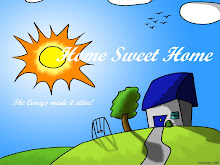A Celtic Journey
 A bank holiday in this part of the world so what better thing to do than nick across to another country for the weekend. Well, not quite a 'separate Country' but the family jumped in the car and headed to Cymru or Wales.
A bank holiday in this part of the world so what better thing to do than nick across to another country for the weekend. Well, not quite a 'separate Country' but the family jumped in the car and headed to Cymru or Wales.
The fist thing you notice when you drive along is the strange warning signs. I soon realised that ARAF is not the sound a dog makes but STOP. ARAFWCH NAWR is not a German concentration camp but REDUCE SPEED NOW and watch out pedestrians as I have no chance of pronouncing CERDDWYR YMLAEN. You get used to calling everything by two names. All the street signs, brochures, labels etc are written in English and Welsh - a clear indication of the divide created when the Saxons cut the land off from the rest of Celtic Britain.
It is interesting (or at least I found it interesting) that the two words have opposite menings - Wales is derived from an old Saxon word meaning foreigners or outsiders. Where as the name Cymru is derived from a word meaning friends or companions.
Anyway – we set of over the open moorland and countryside from Cardiff, through winding roads that stretched their way along the coast until we reached the mountains of the Snowdonia range. The next thing you notice on entering Snowdonia National Park (or is that Parc Cenedlaethol Eryri) that they are not national parks like in Australia. Here you have villages, farms and their associated animals, roads buildings etc. But despite this, there are still some majestic mountains that tower over lovely hidden valleys.
We stayed in a place called Blaenau Ffestiniog which is an old slate mining town surrounded by the National Park. Its defining feature as you enter the town is the huge man made mountain made from slate waste, which provided an unusual and dramatic blot on the landscape. A writer from the Boston Globe wrote "Blaenau Ffestiniog is one of the ugliest spots you'll find in north Wales. The air itself seems permeated with a dark gray cast.... The slate history of the town is everywhere. Stone houses are roofed in slate, stone steps leading through town are slate, and shops feature slate products in their windows. But most striking is the dead landscape that surrounds the town. The hills are lifeless piles of gray rubble. ........ enormous mounds of waste rock now cover the land. A gorgeous place it is not,......". I am not as harsh and thought it was a dramatic contrast to the surrounding landscape that was unique it its own kind of ugly way.
But the real scenery is the national park and a great way to see it was from the Ffestiniog Railway which runs narrow gauge stream trains through the park. The kids had a great time and so did mum and dad.
Unfortunately we had to make our way back home so we did not have time to go north a bit more to visit the little town with the big name 'Llanfairpwllgwyngyllgogerychwyrndrobwllllantysiliogogogoch'. I think it would be much simpler to just call it by its English translation of "The church of St. Mary in the hollow of white hazel trees near the rapid whirlpool by St. Tysilio's of the red cave".
I guess there is always next weekend.



No comments:
Post a Comment